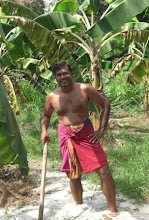I am the only farmer in the whole of the Polonnaruwa District to grow a third rice crop in a year. I am trying this for the first time and it is simply an experiment using water pumped from the river running alongside my property. If the experiment is successful then investing in a high-powered solar powered pump or a windmill used for pumping water may be a worthwhile proposition to guarantee low cost water.
All the experiments I have undertaken to date have not been particularly successful but I have learned a lot and also why some of the expected benefits did not materialize. I have grown 4 different varieties of rice in the 4 seasons I have had the land and this fifth crop is a high value rice that I am planting which I expect to retail at Rs100/kg. Therefore the risk of pumping water at the current cost of kerosene is worth taking so I can at worst brake even on this experiment. None in this whole area has tried different varieties of rice in this small extent of land in such a short time frame. I now have first hand experience of some of the issues that even the so called experts in the land will be hard pressed to count on. My intention is to develop a plan based on practical experience that will with little additional effort, increase the rice production in the country by a third.
I hope this blog will also be useful to a person keen on rice farming at every level and take into their evaluation some of the problems I have had to grapple with. In the current context, I now find that even in my small extent of land my fields vary substantially in quality and soil type. This means that adjacent fields have very different water holding patterns, which is a very important factor in rice cultivation and more so when one is pumping all the water. This is a further example of why our yields are so low. Understanding the soil composition in each section of one’s property is vital in choosing which crops to plant in each section, something the average farmer does not think too much about when he decides to plant as he has numerous other factors to take into account.
Drainage is another factor, as sometimes hand tractors can get water logged in some soil conditions, making is very difficult to till the land using mechanical means. In others the soil can get so hard that the very same tractors cannot plough the same soil and only a large tractor can do an effective job on that.
In performing experiments one has face the ridicule especially from the farmers who have been on the land all their lives. In a kind of way they don’t like to see you succeed either, as you can show them something from being here such a short while, which they were not willing to contemplate doing.
All this practical experience has taught me one salutary lesson. Namely, not to heed the advice of those who extrapolate from figures and numbers in calculating what you should earn or produce in terms of yield. Reality is far different as the factors that can upset theory are many and are often not even contemplated in a theoretical calculation of the possible.
This year has been a particularly bad year as far as agricultural production is concerned, however the opening up of land in the East due to the clearing of the terrorism problem has more than made up for shortfalls in other places.
The hot sun now is the best planting season of the year, however few farmers plant now due to the high cost of irrigating at their expense, and the closure of all tanks which are only providing water to rice farmers during their traditional planting periods. Now all anicuts, sluices are closed and no water flows along the canals, so anyone wishing to cultivate land has to pump from wells or other sources to cultivate and irrigate. Prices of vegetable traditionally rise due to this shortage and the government slaps a temporary import duty on onions to help the local farmer whose onion harvest has just begun, the only time local onions are harvested due to seasonal growing conditions.
Returning to the main point above of being able to cultivate three seasons of rice as opposed to two in the year, the main requirement is the supply of water for cultivation. A well thought out method of ensuring water availability at some areas that are high yielding can both increase the overall yield of the land and also the incomes of the farmers, as well as of course increasing the overall yield. I don’t get subsidized fertilizer for this cultivation and am using some left over from the last season.
I have yet to come up with a resolution of how one deals with very different soil conditions in a small area as it makes it very difficult for a farmer already space constrained in having to make choices of different crops for different fields, as the average yield can be as high as a half less even with the same amount of fertilizer being used. No one it seems to me has even addressed this issue and are surprised when I raise it as it seems a first!
Monday, September 22, 2008
Subscribe to:
Post Comments (Atom)

No comments:
Post a Comment